The conquest of Chernobyl was crucial for opening the road to Kyiv and securing the river line. The Pinsk Flotilla played the first violin in driving the Soviet ships out of Pripyat.
In the spring of 1920, Chernobyl was a very important communication junction and the base of the Dnieper Navy Flotilla. All supplies for the Red Army soldiers fighting in Polesie flowed through the river port. Capturing it would force Soviet ships and infantry to retreat to the Dnieper line.
For the attack on the city, the commander of the 9th Infantry Division, Gen. Władysław Sikorski created the Cavalry Group of Maj. Jaworski, consisting of the 4th squadron of the 1st Mounted Riflemen Regiment, the 3rd Battalion of the 34th Infantry Regiment, the 3rd battery of the 9th Heavy Artillery Regiment and the 2nd battery of the 9th Field Artillery Regiment. The Pinsk Flotilla was to hit the river.
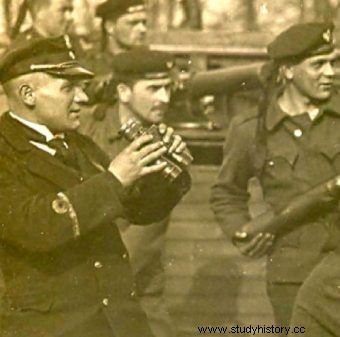
Lt. Mar. Karol Oszek, artillery officer of "Panzer I" during the Battle of Chernobyl.
The Polish river flotilla was established in April 1919. Initially, it consisted of 3 small motorboats. However, it expanded over time. In the spring of 1920, it was already divided into two divisions:transport and combat, which consisted of the armed ship "Pancerny I", the heavy armored motorboat "M.P.I" and three smaller ones:the armed "M.B. I "," M.B. II "and" M.B. III ". In such a composition, it struck the Soviet positions near Chernobyl.
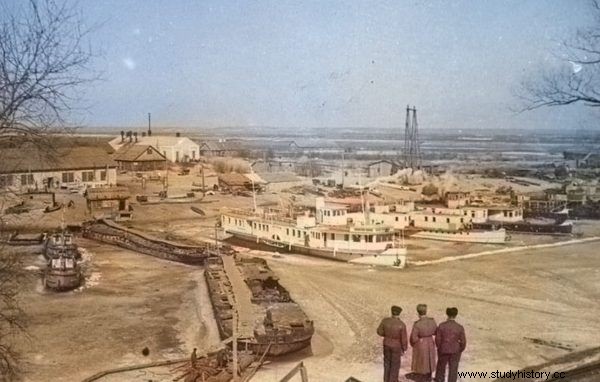
The port of Chernobyl in the early 1930s. It was very similar in 1920.
Prelude
Branches of the group of Maj. Jaworski, they set off on the night of April 22-23 from Sławeczna towards the village of Dernowicze, where they ended up the next day. On April 25, the units reached the line Beniówka - Stare Szepelicze - Nowe Szepelicze. Infantry and artillery moved along the route along the river along which the ships were sailing. Unfortunately, the terrain conditions did not allow for continuous eye contact with the land component.
Downstream of the confluence of Sławeczna and Wica, Pripyat spread widely, creating impassable wetlands and quagmire, which forced the slender line of the road to depart from the bed even for several kilometers. The low banks of the river were overgrown with dense rushes limiting visibility. This made it very difficult to coordinate activities.
The commander of the combat team, Capt. Mar. Olszewski was afraid of meeting an opponent who was much stronger. The Bolsheviks had at least five gunboats on Pripyat. Therefore, the sailors, along with Maj. Jaworski, they developed a plan to lure the enemy into a trap. Armed motorboats, Lt. Mohuca was supposed to attack Soviet armed ships stationed near the Barracks under the cover of the night darkness. The commanders hoped that by simulating a retreat, it would be possible to pull the Bolsheviks under the barrels of Polish guns.
The trap has failed. Polish motorboats ran aground and came under heavy fire from the ship's artillery of the steamers of the Expeditionary Unit No. 1 commanded by the warrior Djaczenko. Kutry had to escape during which 2nd Lt. Mar. de Walden with the only shot from the "M.P. I ”, damaged the Soviet gunboat. The Soviets, busy saving the burning "Prytki", did not give chase. They went down the river. This saved Mohuca's motorboats, because the artillerymen of the 9th Regiment did not manage to take their position. Soon after, the soldiers of the 34th Infantry Regiment seized Koszarówka.
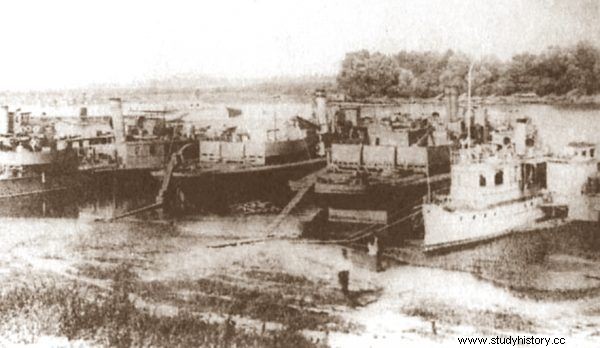
Ships of the Dnieper Flotilla in 1919
Night Battle
A few hours after the clash with the Soviet gunboats, "Pancerny I" joined the motorboats mooring in Koszarówka. There, it was decided to divide the troops into two groups. The first, consisting of a cavalry squadron, the 10th company of the 34th Infantry Regiment, the landing platoon of the Pinsk Flotilla and the 3rd platoon of the 9th pac battery, as well as the Flotilla Combat Division, was to strike Chernobyl from the north. The second column, consisting of the remaining elements of the 3rd Battalion of the 34th Infantry Regiment and the 2nd Battery of the 9th Infantry Regiment, was to be struck from the west.
Around 9 p.m., the fleet's combat team stopped at the shore, about 3-4 kilometers from Lelów, near the village of Kopacze. Olszewski handed over the command to Mohucze, and then went to the staff of Maj. Jaworski to discuss the details of the attack on the fortified village there. An hour later, shots could be heard from the side of the village. At first single, then more and more frequent, machine guns joined the shooting. It was a sign that the infantry was attacking the first line of defense.
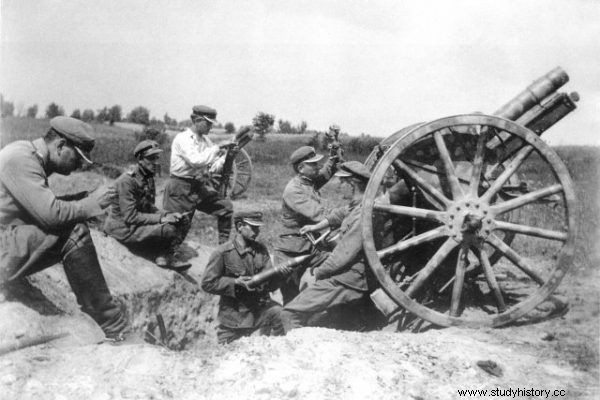
Polish artillerymen in combat positions. Artillery support greatly helped in capturing the city.
An hour and a half later, the sailors on "M.B. II ”they heard the slap of paddle wheels hitting the surface of the water. It was the ships of the Expeditionary Unit No. 1, commanded by the warmor Djachenko, who set out to help their infantry. Hryniewiecki did not open fire for a long time because the enemy stopped the escarpment hidden in the shadow. It was only when a haystack of hay burned on the shore and illuminated the area that he decided to open fire, forcing the Russians to divide their attention between the ship and the infantry. After several dozen minutes of firefight, the Bolsheviks retreated, unable to locate the enemy.
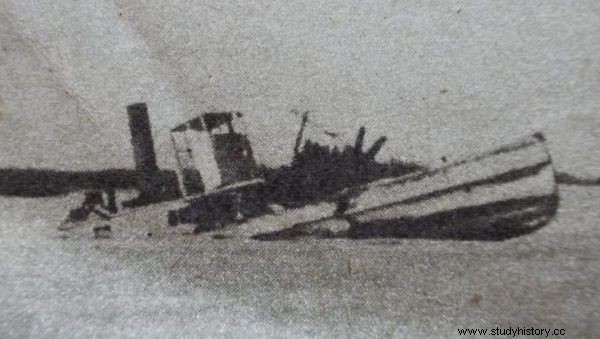
Wreck, which was described by the Polish press at that time as "Gubitelnyj".
In the morning, Djachenko returned. Five Soviet ships started firing at the Polish column, but the sudden attack of "Panzer I" forced the enemy to withdraw. Hryniewiecki, in order to eliminate the quantitative advantage of the enemy, ordered to fire four rounds in rapid succession on a single sight setting. Then there was a correction and four rounds were fired again. This method of shooting made it possible to quickly cover the target. The Soviets, convinced that they were being attacked by a significant enemy team, withdrew towards Chernobyl.
Conquest of Chernobyl
In the chronicle of the activities of the 34th Infantry Regiment it was written that "at dawn the column reached Chernobyl. Lieutenant Galiński set up the battery and, under the cover of its fire, hit the town. The enemy, strengthened in a good position, fiercely defended himself with the support of field and heavy artillery from a dozen or so armored ships. Nevertheless, the 9th and 11th companions managed to capture the city, for which they seized 2 field cannons, 3 machine guns, 4 field kitchens and a dozen prisoners. "
The city was conquered mainly thanks to the very effective support of the 2nd battery of the 9th pile and the 1st battery of the 9th pac., Which, as Maj Józef Nowak wrote:"After a four-day combat march and several skirmishes (...), she arrived on April 27 at Chernobyl from the west. Having taken up the firing position, she prepared with strong fire the attack of infantry and cavalry on the city and the harbor. A bitter fight has begun.
Ships of the enemy flotilla, as well as Soviet artillery, opened violent fire on Polish lines. The missiles severed the telephone connection of the battery with the observation point in several places, making it impossible for the battery commander to direct the fire. At this critical moment, the battery officer, Second Lieutenant Gilewicz, seeing the hopeless efforts of the horse and foot telephones who tried in vain to tie the torn telephone wire, made a quick decision.
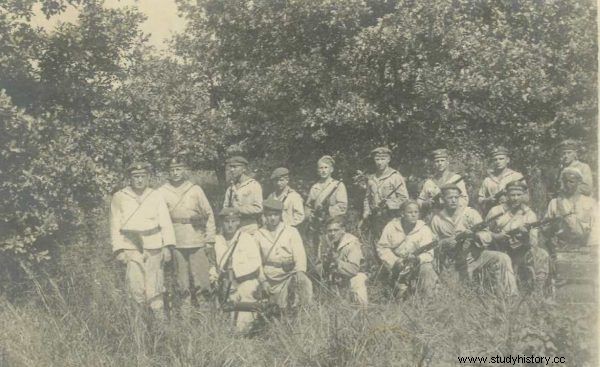
Landing of sailors of the Pinsk Flotilla with a heavy machine gun. The seamen who captured the port of Chernobyl could have looked similar.
Without waiting for any orders, as every minute was a long way, he gave a quick turn and galloped out into the open position. In no time, the battery opened effective fire. The gunners, seeing the enemy at hand, directed the mouths of their cannons at the indicated targets, then volleys rang out one after the other. After two hours of fierce fighting, the city and the harbor were captured, taking prisoners and a lot of war material, including 2 cannons and 8 lizards with ammunition. For this fight they received the 'virtuli militari' crosses of the 5th class:the commander of the 2nd battery, lieutenant Kozakiewicz and the battery officer, second lieutenant Gilewicz. "
Chernobyl was Polish. 15 vessels were captured in the port, including:two armed tugboats "Pokornyj" and a damaged one near the "Prytkij" barracks, four passenger and cargo side-wheelers "Tatiana", "Zwiezda", "Judif" and "Kokietka", and six bucket drag.
Chasing the enemy
Meanwhile, above Chernobyl, the pursuit of the retreating five Soviet gunboats continued. As Karol Taube, the commander of one of the motorboats, recalled:“The Panzer was speeding with all his might. Behind him they pulled out motorboats with all their strength, it was as if dogs were chasing a boar. On the horizon you can barely see the balloons. It is an enemy flotilla. " Soviet ships fleeing towards the Dnieper passed through the city shelling the port and Polish infantry. The artillerymen responded with fire, but the opposing team passed through Chernobyl in full force. Immediately after him, the ships of the Pinsk Flotilla passed through the port.
After passing the city, the Bolsheviks took up positions 7-8 kilometers from the city, on a bend of the river near the forest, facing the river, 600 to 1000 meters wide. Behind them, the ships had a high slope, covered with forest, and then a sharp bend, behind which they could hide in case of failure. There, "Pancerny I" caught up with them along with motorboats. Hryniewiecki sent armed motorboats to hide in one of the bays. Only “M.P. And ”.
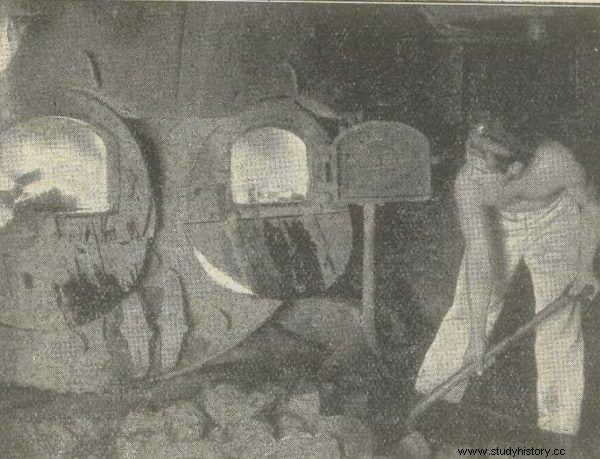
The boiler room of one of the Polish river gunboats. At Chernobyl, the water level reached the furnaces of the boilers.
"Pancerny I" moored to the trees, and Lieutenant Hryniewiecki climbed one of the pines. The fog slowly dissipated, the sun slowly rising, illuminating five gunboats lined up as if on a shooting range. However, before Hryniewiecki established a bearing, the first enemy missiles were fired. A fierce artillery duel has begun.
Over time, Soviet fire became more and more accurate. The Poles were about to withdraw when a high pillar of fire and smoke rose above the enemy team. A shell fired from the bow gun of "Panzer I" hit "Gubitielny". It pierced the side plating, exploded in the boiler room, causing the boiler and the nearby ammunition warehouse to explode. The stern of the gunboat vanished from the surface of the water. The beak went high up. The entire crew of around 30, including the commander, Captain Tugow, died.
The final score
The other four gunboats immediately picked up their anchors and retreated. Hryniewiecki, jumping down from a tree, gave the order to go in pursuit. This time the observation post was placed at the top of the chimney. At its top, a platform made of planks was placed, on which 2nd Lt. Mar. Robert Oszek. As he recalled years later, 2nd Lt. Mar. Taube, Oszek tracked the enemy ships with great skill, having only ordinary binoculars, "he fiddled with his feet a bit, because the smoke was hot".
Despite this, Oszek managed to accurately shoot at two of the four enemy ships. First, the missile hit the amidships of the last ship in the formation. Probably "Mudry". “Mołnijenosnyj” walking in front of him approached him. Trying to throw a haul to "Mudre", he paused. And that one short moment was enough for the Polish missile to reach him. Both ships were covered in smoke. The Soviets, preoccupied with saving the crashed flotilla, stopped firing fire and slowly retreated to the Dnieper.
Hryniewiecki had to give up the pursuit. Due to very rapid fire and nearby explosions, the rivets in the bow had loosened. In the engine room, the mechanics worked knee-deep in the water. The victorious commander decided to return to Chernobyl. Soviet ships withdrew as far as Soz, opening the way for Kyiv.
The Battle of Chernobyl was the greatest victory of Polish sailors during the Polish-Bolshevik war. In memory of this triumph, among the 10 brass plaques commemorating the battles of the Polish Navy, placed on the Tomb of the Unknown Soldier, there is the one with the inscription:Chernobyl 1920.
